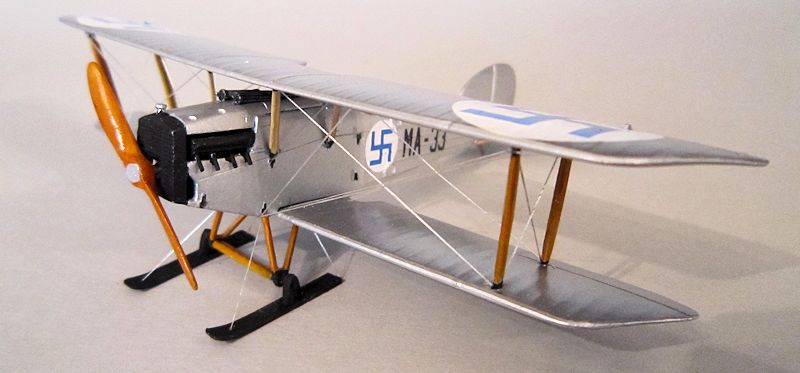
AZ Model 1/72 Martinsyde F.4 Buzzard
| KIT #: | AZ7342 |
| PRICE: | £12.00 SRP |
| DECALS: | Three options |
| REVIEWER: | Chris Peachment |
| NOTES: | Short run with resin engine |

| HISTORY |
In
early 1918 George Handasyde of Martinsyde designed a new fighter powered by a
300hp Hispano-Suiza engine, the F.4 Buzzard.
The prototype F.4 was tested in June 1918, and
demonstrated excellent performance, being easy to fly and manoeuverable
as well as being one of the fastest aircraft of its time. Large orders followed,
with 1,450 ordered from Martinsyde and other manufacturers. It was planned to
equip the French Air Force as well as the RAF and a further 1,500 aircraft for
the USA was planned.
Deliveries to the RAF had just started when WWI ended. Martinsyde completed
those aircraft which were part built, but all other orders were cancelled. The
Buzzard was not adopted as a fighter by the post war RAF,
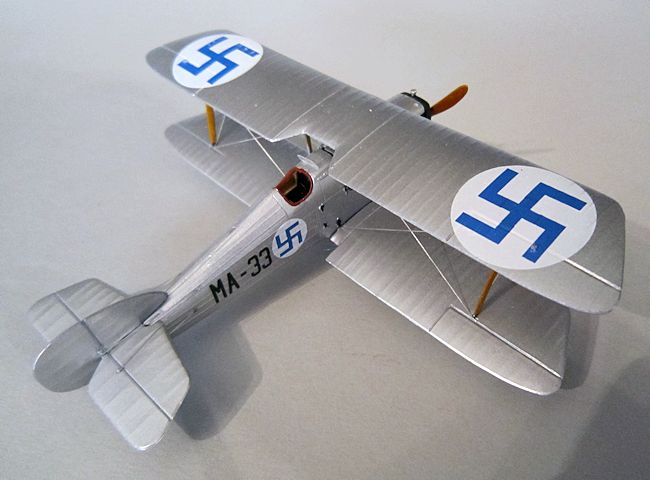 which preferred to use
the Sopwith Snipe, because it was cheaper, in spite of its lower performance.
which preferred to use
the Sopwith Snipe, because it was cheaper, in spite of its lower performance.
Martinsyde bought back many of the surplus aircraft from the RAF, and turned
many into two seat tourers and floatplanes. After the company went bankrupt in
1924, these aircraft were bought by the Aircraft Disposal company
which continued to sell F4 variants for several years.
The RAF had received 57 Buzzards before the end of the WWI, but these did not
reach operational squadrons. The
company had more success selling the Buzzard overseas,
with Spain (30 aircraft), Finland (15 aircraft) and the Soviet Union (100
aircraft).
These aircraft had long careers, with six of the Spanish Buzzards remaining in
service at the start of the Civil War. Eight Jaguar engined versions went to
Latvia and were used until1938. Buzzards were also sold to civil owners for use
as Tourers, racing aircraft and for survey and seal spotting work in Canada.
One notable Buzzard, which might make a nice and simple variant for this kit, competed in the King's Cup Race in 1922. It was coloured yellow overall, and was known as the Musterdside.
| THE KIT |
For the first time, AZ let me down
with this kit. Normally they are of a high standard, especially for a limited
run kit. Perhaps I got a rogue one, but a few of the parts were not well
moulded. The engine front cover especially had poor detail on the radiator
slats, which couldn't be rectified. The fit of the interior was very bad. And
the fuselage didn't mate at all well, due to warping.
| CONSTRUCTION |
The cockpit has a good seat and controls, but as so often happens the whole
thing, especially the floor, was far to wide to fit inside. The only thing to do
is tear it out of whichever side you have cemented it to, and reduce it, this
time brutally with a scalpel, to nearly half its width. Even the seat need
trimming. Re-cement it in place and offer up the other fuselage half before its
sets fully in case more is needed.
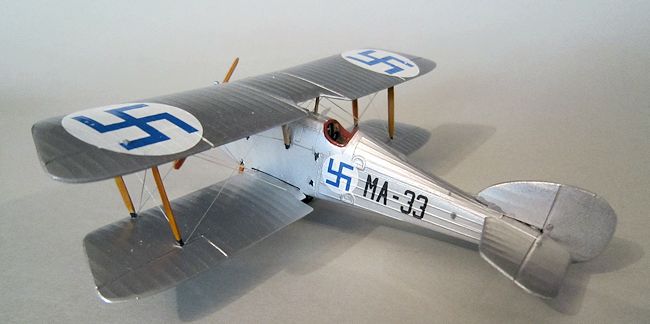 As usual with biplanes, once fuselage and tailplane were in place I sprayed
everything silver, and did
the wings separately. The struts were detached, cleaned of seams, and painted
wood brown. The metal fittings at each end were black, as were some details on
the fuselage such as front cowl fasteners. I tried some Clear Orange on the
struts from the Vallejo range and found that, unlike Tamiya Clear Orange, it
doesn't clump, and it dried matt.
The propeller however would have been polished and so I used the Tamiya Orange
on that.
As usual with biplanes, once fuselage and tailplane were in place I sprayed
everything silver, and did
the wings separately. The struts were detached, cleaned of seams, and painted
wood brown. The metal fittings at each end were black, as were some details on
the fuselage such as front cowl fasteners. I tried some Clear Orange on the
struts from the Vallejo range and found that, unlike Tamiya Clear Orange, it
doesn't clump, and it dried matt.
The propeller however would have been polished and so I used the Tamiya Orange
on that.
Normally I attach the upper wing to the cabanes first and then offer up the main
plane struts. This time however, the cabanes were the wrong length, and induced
a horrible downward slope to the wing. And so I reversed the process by adding
the upper wing to the mainplane struts. Once set, it was a question of offering
up the cabanes with tweezers and adjusting their length accordingly. Not an easy
process but one which is looks much better than the downward slope of the upper
wing the first around.
Notice also, that the main struts are not parallel in alignment. This strikes
the eye as a little off at first, but the photos confirm it is accurate.
Rigging was done by my usual method of elastic thread, coloured silver with a
gel felt tip pen, and anchored using drops of gel superglue applied with a
sharpened toothpick. Note that the rigging here is a little more complicated
than most biplanes. The inter-strut rigging is as normal, but there are extra
wires from the top of
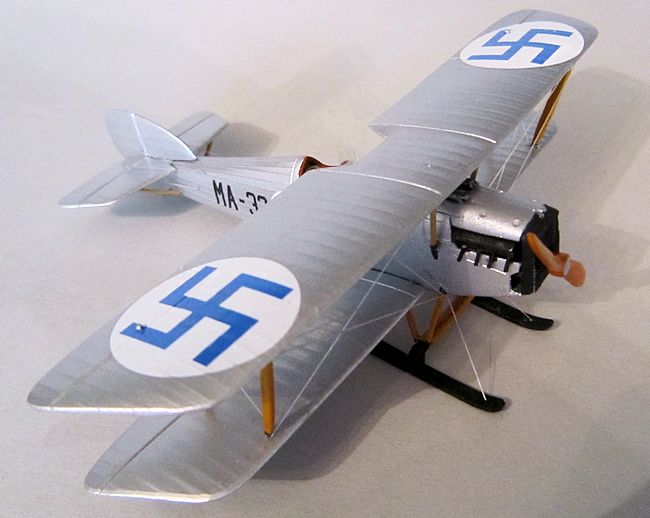 the forward undercarriage leg to the middle of the wing
leading edge and also to the outer strut. Check the photos,
they are very clear. A few
extra wires to the control horns on the tailplanes add a little extra to the
whole appearance.
the forward undercarriage leg to the middle of the wing
leading edge and also to the outer strut. Check the photos,
they are very clear. A few
extra wires to the control horns on the tailplanes add a little extra to the
whole appearance.
One has to make the exhaust pipes from cut lengths of rod, and glue them onto
the cylinder banks. A fiddly job, but worth doing.
The windscreen was not included in the kit, and so a simple rectangle was cut
from clear sheet, and the top corners round off. Clearfix held it in place.
I decided to use the skis shown in the photos below, and cut them from 20 thou
plastic card, and bend the forward edges upward. The mounting fittings were
carved from wide strut rod, and a hole drilled to accept the axle ends. A couple
of wires fore and aft were added as per the photos. And a nice pair of wheels
can be added to your Big Bag of Wheels in the spares box, which is always a
bonus. Handy tip: I cut through the sprue so that they were stored in a pair,
which makes finding them in the future easier.
Finally, as always, the propeller was put in place at ten to four.
| COLORS & MARKINGS |
Nothing very hard here, simply silver overall, with some black details. I
decided on the Finnish option. One reason being that, according to the excellent
pictures of one in a museum on the websites below, the radiator cowl is black,
and thus obscures the worst of the flawed moulding. I could have tried to
scratchbuild a new one but estimated it would have taken longer than the rest of
the kit, to little effect anyway because the black absorbs most of the light.
Decals went on without any problems, something which I always find with AZ kits.
| CONCLUSIONS |
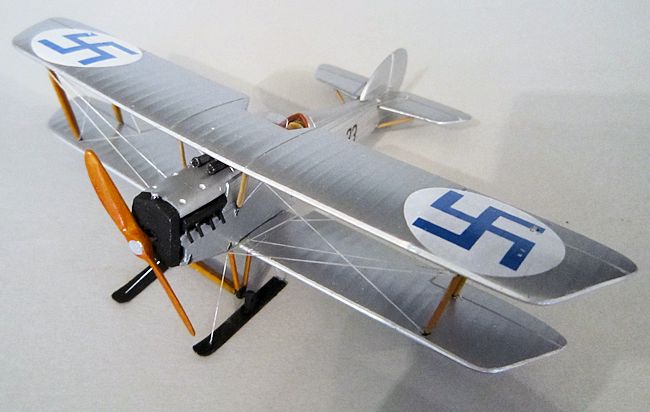 A very purposeful looking fighter and one of the great might-have-beens, thanks
to its engine being much more powerful than any rival. I have made a few Finnish
aircraft, notably the VL Pyry and VL Myrsky from WWII, also by AZ, but this is
my first Finnish biplane. Finland also used the Fokker D VII, in a splinter
camouflage of several colours which might make for a nice companion to this one.
The few caveats above are easily rectified by anyone with a little
experience. And finally one ought to say a large thank you to AZ and many other
Czech companies for making so many aircraft which the mainstream manufacturers
ignore. Think back to 30 years ago, and you will realise how few exotic or
unusual aircraft were on offer. We are living in times of plenty.
A very purposeful looking fighter and one of the great might-have-beens, thanks
to its engine being much more powerful than any rival. I have made a few Finnish
aircraft, notably the VL Pyry and VL Myrsky from WWII, also by AZ, but this is
my first Finnish biplane. Finland also used the Fokker D VII, in a splinter
camouflage of several colours which might make for a nice companion to this one.
The few caveats above are easily rectified by anyone with a little
experience. And finally one ought to say a large thank you to AZ and many other
Czech companies for making so many aircraft which the mainstream manufacturers
ignore. Think back to 30 years ago, and you will realise how few exotic or
unusual aircraft were on offer. We are living in times of plenty.
| REFERENCES |
http://commons.wikimedia.org/wiki/File:Martinsyde_F.4_Buzzard_(MA-24)_K-SIM_01.jpg
http://commons.wikimedia.org/wiki/File:Martinsyde_F.4_Buzzard_(MA-24)_K-SIM_03.jpg
http://commons.wikimedia.org/wiki/File:Martinsyde_F.4_Buzzard_(MA-24)_K-SIM_04.jpg
http://mil-history.livejournal.com/1036486.html
Thanks t
If you would like your product reviewed fairly and fairly quickly, please contact the editor or see other details in the Note to Contributors.